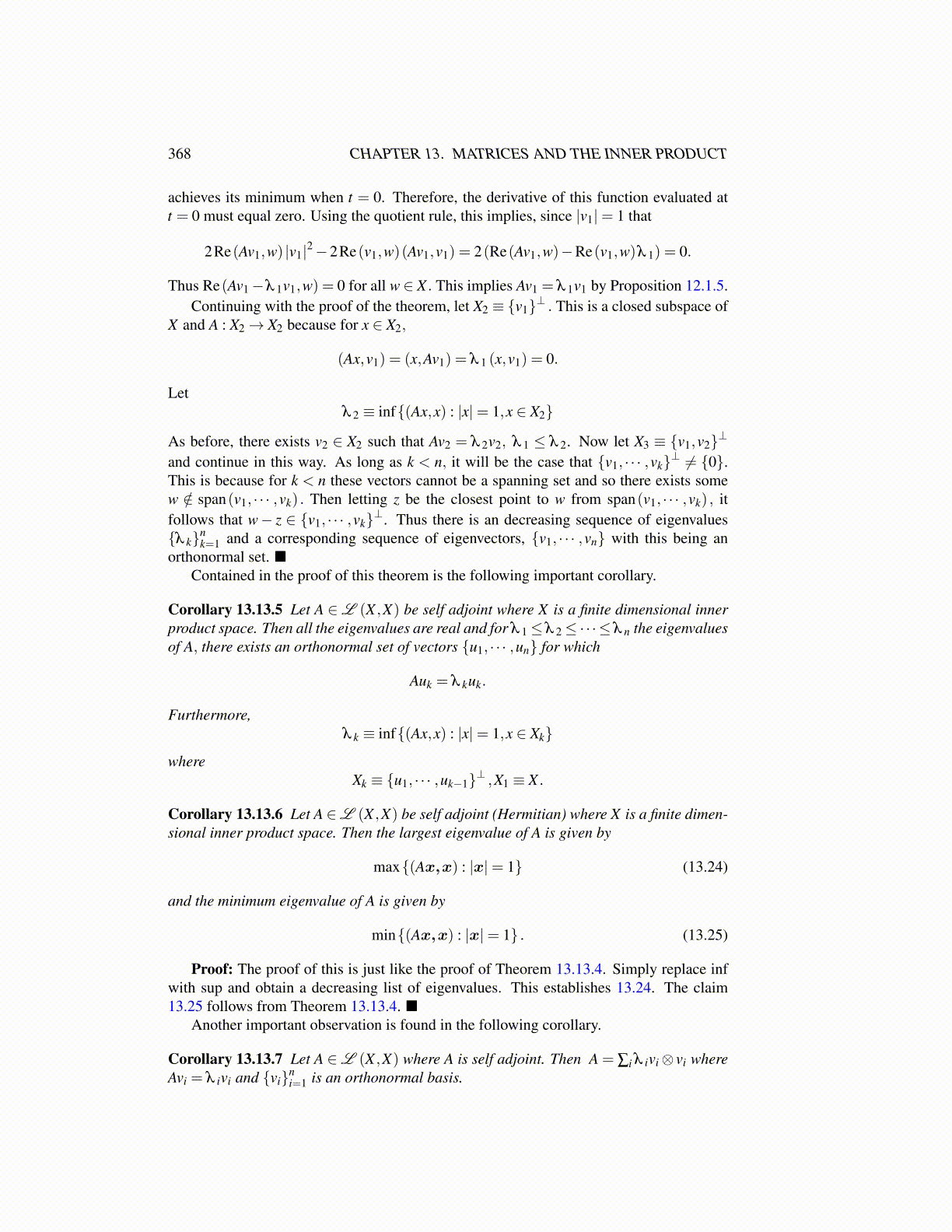
368 CHAPTER 13. MATRICES AND THE INNER PRODUCT
achieves its minimum when t = 0. Therefore, the derivative of this function evaluated att = 0 must equal zero. Using the quotient rule, this implies, since |v1|= 1 that
2Re(Av1,w) |v1|2−2Re(v1,w)(Av1,v1) = 2(Re(Av1,w)−Re(v1,w)λ 1) = 0.
Thus Re(Av1−λ 1v1,w) = 0 for all w ∈ X . This implies Av1 = λ 1v1 by Proposition 12.1.5.Continuing with the proof of the theorem, let X2 ≡ {v1}⊥ . This is a closed subspace of
X and A : X2→ X2 because for x ∈ X2,
(Ax,v1) = (x,Av1) = λ 1 (x,v1) = 0.
Letλ 2 ≡ inf{(Ax,x) : |x|= 1,x ∈ X2}
As before, there exists v2 ∈ X2 such that Av2 = λ 2v2, λ 1 ≤ λ 2. Now let X3 ≡ {v1,v2}⊥
and continue in this way. As long as k < n, it will be the case that {v1, · · · ,vk}⊥ ̸= {0}.This is because for k < n these vectors cannot be a spanning set and so there exists somew /∈ span(v1, · · · ,vk) . Then letting z be the closest point to w from span(v1, · · · ,vk) , itfollows that w− z ∈ {v1, · · · ,vk}⊥. Thus there is an decreasing sequence of eigenvalues{λ k}n
k=1 and a corresponding sequence of eigenvectors, {v1, · · · ,vn} with this being anorthonormal set. ■
Contained in the proof of this theorem is the following important corollary.
Corollary 13.13.5 Let A ∈L (X ,X) be self adjoint where X is a finite dimensional innerproduct space. Then all the eigenvalues are real and for λ 1≤ λ 2≤ ·· · ≤ λ n the eigenvaluesof A, there exists an orthonormal set of vectors {u1, · · · ,un} for which
Auk = λ kuk.
Furthermore,λ k ≡ inf{(Ax,x) : |x|= 1,x ∈ Xk}
whereXk ≡ {u1, · · · ,uk−1}⊥ ,X1 ≡ X .
Corollary 13.13.6 Let A ∈L (X ,X) be self adjoint (Hermitian) where X is a finite dimen-sional inner product space. Then the largest eigenvalue of A is given by
max{(Ax,x) : |x|= 1} (13.24)
and the minimum eigenvalue of A is given by
min{(Ax,x) : |x|= 1} . (13.25)
Proof: The proof of this is just like the proof of Theorem 13.13.4. Simply replace infwith sup and obtain a decreasing list of eigenvalues. This establishes 13.24. The claim13.25 follows from Theorem 13.13.4. ■
Another important observation is found in the following corollary.
Corollary 13.13.7 Let A ∈L (X ,X) where A is self adjoint. Then A = ∑i λ ivi⊗ vi whereAvi = λ ivi and {vi}n
i=1 is an orthonormal basis.